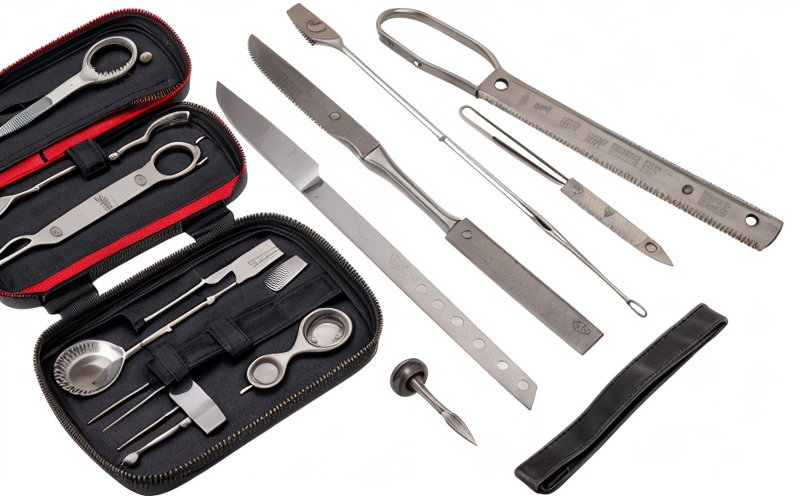Needle Fracture Resistance Testing
The integrity and safety of surgical instruments are paramount in ensuring patient well-being. Needle fracture resistance testing is a critical process that evaluates the mechanical strength of needles used in surgical procedures, particularly those involving sutures or similar applications. This test assesses how much force can be applied to a needle before it fractures, thereby determining its durability under stress.
Understanding the principles behind this type of testing begins with recognizing the importance of standardization. The International Organization for Standardization (ISO) provides guidelines in ISO 13405-2:2016, which specifies the method for tensile testing of sutures and needles used in surgical procedures. Compliance with these standards ensures that tests are conducted under consistent conditions across different manufacturers.
During needle fracture resistance testing, specimens are prepared by selecting representative samples from production batches. These samples undergo a series of mechanical stress tests using specialized equipment designed to simulate real-world usage scenarios as closely as possible. The apparatus typically consists of a tensile tester capable of applying controlled loads while measuring displacement and force.
The testing process involves attaching one end of the needle specimen to the machine's fixture, followed by gradually increasing the load until fracture occurs. At this point, detailed measurements are taken regarding the amount of load applied before failure as well as any deformation observed along the way. This data helps engineers refine design parameters for future iterations of the product.
Accurate reporting is crucial in needle fracture resistance testing. Results should include maximum load to failure, elongation at break, and visual inspection notes on surface condition post-test. By analyzing these metrics alongside other quality assurance measures like dimensional accuracy and material composition analysis, manufacturers can ensure their products meet regulatory requirements and provide safe performance.
It is important to note that while this level of testing focuses primarily on mechanical properties, it does not address biocompatibility issues which are addressed through separate assessments. However, successful completion of fracture resistance tests provides confidence in the structural integrity of surgical instruments made from biocompatible materials.
In conclusion, needle fracture resistance testing plays a vital role in safeguarding patient health by ensuring that needles used during surgery do not break under normal operating conditions. By adhering to established standards and employing rigorous methodologies, laboratories can deliver reliable results that support informed decision-making throughout the product lifecycle from development through manufacturing all the way up to post-market surveillance.
Industry Applications
- Surgical Instrument Manufacturers: This testing is essential for ensuring quality control during production processes, helping companies identify potential weaknesses in their designs early on so they can address them before products reach clinical use.
- Hospitals and Clinics: By verifying the strength of needles used across various surgical procedures, healthcare facilities can maintain high standards of patient care while minimizing risks associated with compromised instruments.
- Regulatory Bodies: Compliance with ISO standards ensures that all parties involved in the medical device industry adhere to best practices when it comes to ensuring product safety and efficacy.
These applications underscore why needle fracture resistance testing remains a cornerstone of quality assurance efforts within the surgical instrument sector. It not only contributes directly to improved patient outcomes but also fosters trust between stakeholders by demonstrating adherence to stringent international standards.
Customer Impact and Satisfaction
- Better Patient Outcomes: Ensuring that needles do not break during use reduces the risk of complications, enhancing overall patient safety.
- Improved Quality Assurance: Reliable testing provides assurance for manufacturers about product reliability, leading to more consistent performance across different batches and lots.
- Enhanced Reputation: Compliance with ISO standards helps build a reputation for quality among both internal teams and external partners in the medical device industry.
The positive impact on customer satisfaction cannot be overstated. Hospitals and clinics that trust in the reliability of their surgical instruments can offer more secure environments where patients feel safe knowing they are receiving top-notch care supported by robust quality assurance practices.
Environmental and Sustainability Contributions
In addition to its direct benefits for healthcare providers, needle fracture resistance testing also contributes positively towards environmental sustainability. By identifying design flaws early in the development process, manufacturers can reduce waste associated with substandard products that might otherwise end up as landfill.
This focus on minimizing unnecessary production runs translates into lower energy consumption and reduced greenhouse gas emissions throughout the supply chain. Furthermore, by promoting longer-lasting tools, there is less need for frequent replacements which again helps to conserve resources and protect natural environments.
The commitment to sustainable practices does not stop at reducing waste but also extends to proper disposal methods when needles reach end-of-life stages. Through comprehensive testing protocols like needle fracture resistance, medical device companies contribute significantly towards creating a more responsible approach to healthcare product management.





